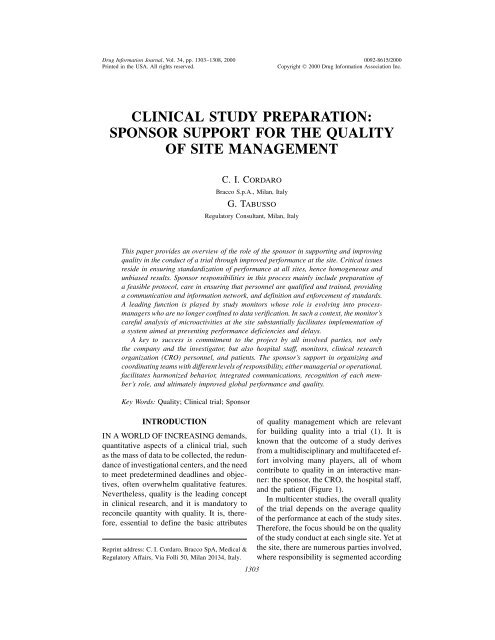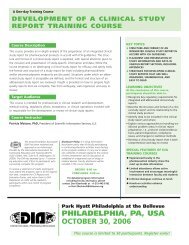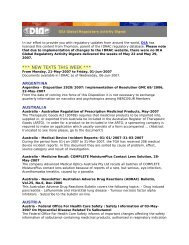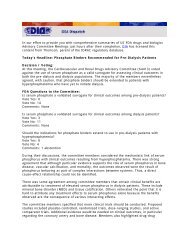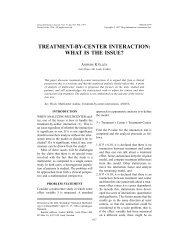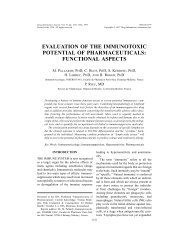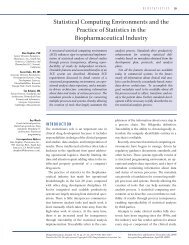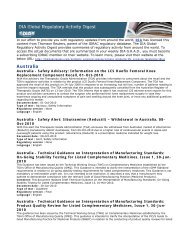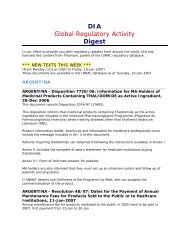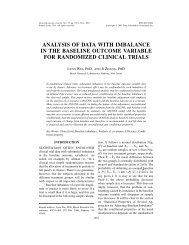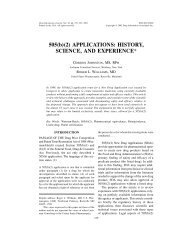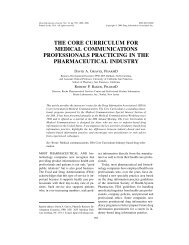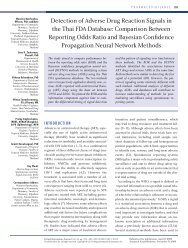sponsor support for the quality of site management - Drug ...
sponsor support for the quality of site management - Drug ...
sponsor support for the quality of site management - Drug ...
You also want an ePaper? Increase the reach of your titles
YUMPU automatically turns print PDFs into web optimized ePapers that Google loves.
<strong>Drug</strong> In<strong>for</strong>mation Journal, Vol. 34, pp. 1303–1308, 2000 0092-8615/2000<br />
Printed in <strong>the</strong> USA. All rights reserved. Copyright © 2000 <strong>Drug</strong> In<strong>for</strong>mation Association Inc.<br />
CLINICAL STUDY PREPARATION:<br />
SPONSOR SUPPORT FOR THE QUALITY<br />
OF SITE MANAGEMENT<br />
C. I. CORDARO<br />
Bracco S.p.A., Milan, Italy<br />
G. TABUSSO<br />
Regulatory Consultant, Milan, Italy<br />
This paper provides an overview <strong>of</strong> <strong>the</strong> role <strong>of</strong> <strong>the</strong> <strong>sponsor</strong> in <strong>support</strong>ing and improving<br />
<strong>quality</strong> in <strong>the</strong> conduct <strong>of</strong> a trial through improved per<strong>for</strong>mance at <strong>the</strong> <strong>site</strong>. Critical issues<br />
reside in ensuring standardization <strong>of</strong> per<strong>for</strong>mance at all <strong>site</strong>s, hence homogeneous and<br />
unbiased results. Sponsor responsibilities in this process mainly include preparation <strong>of</strong><br />
a feasible protocol, care in ensuring that personnel are qualified and trained, providing<br />
a communication and in<strong>for</strong>mation network, and definition and en<strong>for</strong>cement <strong>of</strong> standards.<br />
A leading function is played by study monitors whose role is evolving into processmanagers<br />
who are no longer confined to data verification. In such a context, <strong>the</strong> monitor’s<br />
careful analysis <strong>of</strong> microactivities at <strong>the</strong> <strong>site</strong> substantially facilitates implementation <strong>of</strong><br />
a system aimed at preventing per<strong>for</strong>mance deficiencies and delays.<br />
A key to success is commitment to <strong>the</strong> project by all involved parties, not only<br />
<strong>the</strong> company and <strong>the</strong> investigator, but also hospital staff, monitors, clinical research<br />
organization (CRO) personnel, and patients. The <strong>sponsor</strong>’s <strong>support</strong> in organizing and<br />
coordinating teams with different levels <strong>of</strong> responsibility, ei<strong>the</strong>r managerial or operational,<br />
facilitates harmonized behavior, integrated communications, recognition <strong>of</strong> each member’s<br />
role, and ultimately improved global per<strong>for</strong>mance and <strong>quality</strong>.<br />
Key Words: Quality; Clinical trial; Sponsor<br />
INTRODUCTION <strong>of</strong> <strong>quality</strong> <strong>management</strong> which are relevant<br />
IN A WORLD OF INCREASING demands,<br />
quantitative aspects <strong>of</strong> a clinical trial, such<br />
as <strong>the</strong> mass <strong>of</strong> data to be collected, <strong>the</strong> redun-<br />
dance <strong>of</strong> investigational centers, and <strong>the</strong> need<br />
to meet predetermined deadlines and objec-<br />
tives, <strong>of</strong>ten overwhelm qualitative features.<br />
Never<strong>the</strong>less, <strong>quality</strong> is <strong>the</strong> leading concept<br />
in clinical research, and it is mandatory to<br />
reconcile quantity with <strong>quality</strong>. It is, <strong>the</strong>re-<br />
<strong>for</strong>e, essential to define <strong>the</strong> basic attributes<br />
<strong>for</strong> building <strong>quality</strong> into a trial (1). It is<br />
known that <strong>the</strong> outcome <strong>of</strong> a study derives<br />
from a multidisciplinary and multifaceted ef<strong>for</strong>t<br />
involving many players, all <strong>of</strong> whom<br />
contribute to <strong>quality</strong> in an interactive manner:<br />
<strong>the</strong> <strong>sponsor</strong>, <strong>the</strong> CRO, <strong>the</strong> hospital staff,<br />
and <strong>the</strong> patient (Figure 1).<br />
In multicenter studies, <strong>the</strong> overall <strong>quality</strong><br />
<strong>of</strong> <strong>the</strong> trial depends on <strong>the</strong> average <strong>quality</strong><br />
<strong>of</strong> <strong>the</strong> per<strong>for</strong>mance at each <strong>of</strong> <strong>the</strong> study <strong>site</strong>s.<br />
There<strong>for</strong>e, <strong>the</strong> focus should be on <strong>the</strong> <strong>quality</strong><br />
<strong>of</strong> <strong>the</strong> study conduct at each single <strong>site</strong>. Yet at<br />
Reprint address: C. I. Cordaro, Bracco SpA, Medical & <strong>the</strong> <strong>site</strong>, <strong>the</strong>re are numerous parties involved,<br />
Regulatory Affairs, Via Folli 50, Milan 20134, Italy. where responsibility is segmented according<br />
1303
1304 C. I. Cordaro and G. Tabusso<br />
FIGURE 1. A high-<strong>quality</strong> study relies on an interactive multidisciplinary ef<strong>for</strong>t <strong>of</strong> all<br />
<strong>the</strong> involved parties.<br />
to <strong>the</strong> specific function: principal investiga- <strong>sponsor</strong> during <strong>the</strong> design, preparatory activi-<br />
tor, coinvestigators, nurses, administrative ties and implementation <strong>of</strong> a clinical study.<br />
staff, laboratories (if not centralized), phar- Ensuring that <strong>the</strong> investigator, hospital staff<br />
macist or drug dispensing person, <strong>the</strong> institu- and IRBs pursue strict observance <strong>of</strong> Good<br />
tional review board (IRB), and <strong>the</strong> monitor Clinical Practice (GCP) requirements must<br />
<strong>of</strong> <strong>the</strong> <strong>sponsor</strong> company or <strong>of</strong> <strong>the</strong> clinical<br />
research organization. The global responsi-<br />
be a primary <strong>sponsor</strong> concern (2).<br />
bility, however, rests with <strong>the</strong> <strong>sponsor</strong> which<br />
must <strong>support</strong> and coordinate <strong>the</strong> activities<br />
<strong>of</strong> <strong>the</strong> various parties to a successful global<br />
per<strong>for</strong>mance (2). Stemming from models<br />
rooted in past experience, innovative techni-<br />
cal and managerial approaches may be de-<br />
vised to improve study conduct. This paper<br />
is not aimed at presenting a complete manual<br />
<strong>for</strong> clinical research, but ra<strong>the</strong>r at highlight-<br />
ing a number <strong>of</strong> points critical to <strong>the</strong> <strong>quality</strong><br />
<strong>of</strong> <strong>the</strong> study.<br />
The Protocol and <strong>the</strong> Case Record Form<br />
One <strong>of</strong> <strong>the</strong> most effective means <strong>of</strong> prevent-<br />
ing potential complications is to identify <strong>the</strong><br />
most adequate study design to verify <strong>the</strong> test<br />
hypo<strong>the</strong>sis (3,4). The protocol should define<br />
clear and measurable objectives and should<br />
not try to prove too many hypo<strong>the</strong>ses.<br />
Involvement <strong>of</strong> actual investigators through<br />
an early investigators’ meeting may provide<br />
a valuable contribution in verifying <strong>the</strong> target<br />
population, and confirming <strong>the</strong> study design,<br />
POINTS TO CONSIDER WHEN<br />
PLANNING A MULTICENTER<br />
CLINICAL STUDY<br />
<strong>the</strong> clinical parameters to be measured, and<br />
<strong>the</strong> assessment methodology.<br />
A complex and not straight<strong>for</strong>ward protocol<br />
may introduce interpretative uncertain-<br />
The <strong>quality</strong> <strong>of</strong> <strong>the</strong> <strong>site</strong> <strong>management</strong> depends ties. Fur<strong>the</strong>rmore, all <strong>the</strong> parts <strong>of</strong> <strong>the</strong> protocol<br />
on planning activities in <strong>the</strong> framework <strong>of</strong> not directly related to <strong>the</strong> study conduct, such<br />
specific processes, as well as on implementa- as administrative parts and general in<strong>for</strong>mation<br />
<strong>of</strong> a system aimed at preventing deficien- tion, may be assembled in a separate section.<br />
cies. A number <strong>of</strong> critical issues contributing In any case, flow charts showing <strong>the</strong> se-<br />
to <strong>the</strong> <strong>quality</strong> <strong>of</strong> <strong>the</strong> <strong>site</strong> <strong>management</strong> (Figure quence <strong>of</strong> activities will be <strong>of</strong> help to <strong>the</strong><br />
2) should be taken into consideration by <strong>the</strong><br />
involved staff in understanding <strong>the</strong> protocol
Sponsor Support <strong>for</strong> Quality Clinical Site Management 1305<br />
FIGURE 2. Critical elements requiring coordination and <strong>support</strong> by <strong>the</strong> <strong>sponsor</strong>.<br />
requi<strong>site</strong>s. Paying a visit to <strong>the</strong> ward and quence <strong>of</strong> events to answer <strong>the</strong> study ques-<br />
understanding responsibilities, activities, and tions is pivotal <strong>for</strong> improving study <strong>quality</strong><br />
roles within <strong>the</strong> department will facilitate and protocol compliance. The CRF should<br />
generation <strong>of</strong> a feasible protocol.<br />
be structured in such a way as to avoid over-<br />
For a study to become successful, two load <strong>of</strong> in<strong>for</strong>mation and to optimize real time<br />
main objectives must be pursued: 1. assess- data collection and unbiased data processing.<br />
ment <strong>of</strong> feasibility at all <strong>site</strong>s, and 2. homoge- To facilitate documentation and processing<br />
neity <strong>of</strong> data collected (Table 1). The latter <strong>of</strong> data, <strong>the</strong> <strong>site</strong>’s customary source documen-<br />
is closely related to homogeneity <strong>of</strong> study tation should be checked and verified versus<br />
conduct, and leads to reduced deviations, vi- <strong>the</strong> CRF data to be collected. If no source<br />
olations, and errors. To prevent misunder- document contains <strong>the</strong> requested in<strong>for</strong>mastandings<br />
and inconsistencies, a true agreetion, appropriate notes that will become <strong>of</strong>fiment<br />
on <strong>the</strong> protocol scope and structure <strong>of</strong> cial hospital notes and source documents <strong>for</strong><br />
<strong>the</strong> study design, as well as on trial methodology,<br />
should be reached between <strong>sponsor</strong>,<br />
<strong>the</strong> study should be prepared.<br />
CRO, and staff at <strong>the</strong> <strong>site</strong>.<br />
A user-friendly case record <strong>for</strong>m (CRF) Personnel and Communication<br />
focused on essential in<strong>for</strong>mation and <strong>the</strong> se-<br />
It is a <strong>sponsor</strong>’s responsibility to guarantee<br />
adequate and qualified resources, <strong>the</strong>re<strong>for</strong>e,<br />
TABLE 1<br />
Factors Relevant to a<br />
Feasible Protocol and CRF<br />
trained and experienced investigators and<br />
monitors should be selected (5). Where necessary,<br />
specific and effective training should<br />
be provided. Training tools, including video-<br />
Study Planning<br />
Selection <strong>of</strong> an adequate study design<br />
Involvement <strong>of</strong> investigators in <strong>the</strong> design <strong>of</strong><br />
<strong>the</strong> protocol/CRF<br />
recorded instructions and coaching by senior<br />
<strong>of</strong>ficers, would be desirable <strong>for</strong> qualifying<br />
junior coinvestigators or monitors.<br />
Feasibility <strong>of</strong> <strong>the</strong> schedule <strong>of</strong> events A team approach is useful to improve effi-<br />
Optimization <strong>of</strong> data to be collected by a<br />
user-friendly CRF<br />
Identification <strong>of</strong> recruitment possibilities<br />
ciency, to foster harmonized behavior, and<br />
ultimately, to improve <strong>quality</strong>. These teams<br />
should include key persons at different levels
1306 C. I. Cordaro and G. Tabusso<br />
and from different structures, such as a spon- <strong>of</strong> <strong>quality</strong> standards to be followed. Once <strong>the</strong><br />
sor/CRO team with managerial tasks, or a protocol and <strong>the</strong> basic concepts have been<br />
CRO/<strong>sponsor</strong>/hospital staff team with opera- defined, <strong>the</strong> application phase, aimed at<br />
tional objectives (6,7,8). The <strong>sponsor</strong>’s ef- achieving standardization <strong>of</strong> trial methodol<strong>for</strong>ts<br />
should be devoted to creating a con- ogy, begins. This phase principally covers<br />
structive, motivated environment leading to materials, instruments, methods, and instruc-<br />
integrated communications (Table 2) (8,9). tions. At this point, among <strong>the</strong> critical issues<br />
Realization <strong>of</strong> <strong>the</strong>se conditions ensures to be considered <strong>the</strong> following can be countthat<br />
each person involved feels like an active ed: availability <strong>of</strong> Good Manufacturing<br />
and respected player in <strong>the</strong> project; this also Practice (GMP) clinical material; labels in<br />
contributes to consistent and accurate per<strong>for</strong>- compliance with <strong>the</strong> relevant regulatory remance<br />
in terms <strong>of</strong> <strong>quality</strong> and timing. Supquirements; organization <strong>of</strong> specimen collecportive<br />
participation <strong>of</strong> <strong>the</strong> <strong>sponsor</strong>’s manag- tion and handling, labeling, and shipment<br />
ers in team activities substantiates <strong>the</strong> interest where necessary; homogeneity <strong>of</strong> methods;<br />
<strong>of</strong> <strong>the</strong> company in <strong>the</strong> project and fosters a instrumentation and standards; equipment<br />
collaborative attitude (10).<br />
calibration; and adverse events reporting.<br />
Appropriate communication should be Comprehensive instructions prepared by<br />
valued and <strong>the</strong> exchange <strong>of</strong> in<strong>for</strong>mation <strong>the</strong> company should be carefully reviewed<br />
should be facilitated, taking advantage <strong>of</strong> in conjunction with each investigator and rel-<br />
electronic technology and networking, such evant hospital staff to identify <strong>site</strong>-specific<br />
as online data transfer among team members, adjustments which facilitate compliance,<br />
centralized safety data mapping, and in<strong>for</strong>- without jeopardizing homogeneity <strong>of</strong> data<br />
mation technology <strong>support</strong> <strong>for</strong> project coor- generation and handling. It is, <strong>the</strong>re<strong>for</strong>e, fun-<br />
dination and status tracking, and so <strong>for</strong>th damental that <strong>the</strong> monitor understand <strong>the</strong><br />
(7,8,9). specific hospital system, and ensure that <strong>the</strong><br />
instructions are adapted to <strong>the</strong> processes and<br />
The Processes<br />
<strong>the</strong> organization <strong>of</strong> <strong>the</strong> <strong>site</strong>. He/she must understand<br />
<strong>the</strong> roles and responsibilities <strong>of</strong> <strong>the</strong><br />
Be<strong>for</strong>e any study starts, critical paths need hospital staff and identify who could per<strong>for</strong>m<br />
to be identified both inside and outside <strong>the</strong> <strong>the</strong> relevant task to avoid out-<strong>of</strong>-scope per-<br />
company. Internal and external activities are <strong>for</strong>mance or nonper<strong>for</strong>mance. He/she should<br />
usually identified by a sequential and interac- become familiar with individual <strong>site</strong> organi-<br />
tive sets <strong>of</strong> tasks which can be classified as zation, documentation, and procedures. He/<br />
conceptual and applied. The conceptual as- she should also become acquainted with <strong>the</strong><br />
pects cover protocol outline, feasibility as- structure and <strong>for</strong>mat <strong>of</strong> hospital patient recsessment,<br />
protocol discussion, and definition ords to easily identify medical history, concomitant<br />
medication, adverse events, and so<br />
TABLE 2<br />
Key Elements <strong>for</strong> a Collaborative<br />
and Integrated Environment<br />
<strong>for</strong>th. Later on during <strong>the</strong> study, this will<br />
allow <strong>for</strong> a correct source data verification<br />
and scrutiny <strong>of</strong> adverse events. A flow chart<br />
<strong>of</strong> specified processes, that is, patient man-<br />
A Team Approach<br />
Empowerment: Project leader and team are<br />
responsible <strong>for</strong> <strong>management</strong> and outcome<br />
Commitment on <strong>the</strong> project<br />
Shared responsibility<br />
Integrated communications<br />
agement, handling <strong>of</strong> clinical trial material,<br />
record keeping, drug dispensing, blood col-<br />
lection and shipment, and lab data medical<br />
evaluation, should be prepared, and written<br />
directions left with <strong>the</strong> <strong>site</strong> staff.<br />
Recognition <strong>of</strong> each member’s role<br />
Value <strong>of</strong> intense goal and action-oriented<br />
activities<br />
At <strong>the</strong> <strong>site</strong>, a dedicated full-time study<br />
coordinator is <strong>the</strong> backbone <strong>of</strong> a clinical trial.<br />
This is particularly true <strong>for</strong> Europe where
Sponsor Support <strong>for</strong> Quality Clinical Site Management 1307<br />
most trials are conducted in state-run venues to <strong>the</strong> follow-up visits, will increase global<br />
and investigators and hospital staff are state<br />
employees and part-time researchers. Briefing<br />
<strong>the</strong> hospital staff and rehearsing each sin-<br />
protocol compliance.<br />
gle process in <strong>the</strong> development <strong>of</strong> a clinical<br />
trial facilitates procedural compliance. Re-<br />
CONCLUSION<br />
hearsal should be per<strong>for</strong>med with all <strong>of</strong> <strong>the</strong> All <strong>of</strong> <strong>the</strong> conceptual and operational aspects<br />
involved personnel, that is, nurse, coinvesti- that contribute to building <strong>quality</strong> into a study<br />
gator, referring department physician, and must be predisposed by <strong>the</strong> <strong>sponsor</strong> in such<br />
principal investigator. a way that <strong>quality</strong> becomes an intrinsic value.<br />
The “hidden” hospital staff, that is, those A well-thought out, feasible protocol and an<br />
involved in activities not immediately visible easy-to-use CRF, availability <strong>of</strong> communicaat<br />
<strong>the</strong> department, are to be taken into consid- tion technology, and care <strong>for</strong> those coneration.<br />
The nurse or <strong>the</strong> person who collects ducting <strong>the</strong> trial are basic elements <strong>of</strong> <strong>the</strong><br />
blood, <strong>the</strong> administrative person who <strong>for</strong>- <strong>sponsor</strong>’s <strong>support</strong>. Optimization <strong>of</strong> <strong>the</strong> involvewards<br />
<strong>the</strong> specimen via courier to <strong>the</strong> central ment <strong>of</strong> all <strong>of</strong> <strong>the</strong> personnel participating in<br />
lab, <strong>the</strong> pharmacist and drug dispensing per- <strong>the</strong> study through a team approach with <strong>the</strong><br />
son, and <strong>the</strong> administrative person in charge company, CRO, and investigational <strong>site</strong>s, will<br />
<strong>of</strong> <strong>the</strong> document tracking and archiving contribute to achievement <strong>of</strong> a <strong>quality</strong> and sucshould<br />
all be briefed. The relevant flow chart cessful study. In this framework, <strong>the</strong> study<br />
<strong>of</strong> activities could be <strong>of</strong> help <strong>for</strong> <strong>the</strong> various monitors’ role is prospectively evolving from<br />
segments <strong>of</strong> <strong>the</strong> processes. checkers <strong>of</strong> documents and data into process<br />
What are generally thought to be trivial managers acting as coordinators <strong>of</strong> all pertinent<br />
operation details, such as collection <strong>of</strong> blood,<br />
centrifugation and handling <strong>of</strong> samples <strong>for</strong><br />
shipment, archiving results into <strong>the</strong> appropriate<br />
activities at <strong>the</strong> <strong>site</strong>.<br />
file, and collecting safety lab results should not<br />
be disregarded. Negligence in <strong>the</strong>se operations<br />
REFERENCES<br />
can evolve into substantial delays, scientific 1. Tabusso G. Quality education: Regulatory aspects<br />
problems, or study failures (11).<br />
in <strong>the</strong> pharmaceutical industry. <strong>Drug</strong> Inf J. 1995;29:<br />
1275–1283.<br />
2. Barton BL. International Conference on Harmonization—Good<br />
Clinical Practices update. <strong>Drug</strong> Inf J.<br />
The Patient<br />
1998;32:1143–1147.<br />
3. Donahue RMJ, Ruberg SJ. Standardizing clinical<br />
The patient is <strong>the</strong> principal player in any study designs <strong>for</strong> accelerating drug development.<br />
clinical trial. His/her active contribution to<br />
<strong>the</strong> <strong>quality</strong> <strong>of</strong> a clinical trial should be valued.<br />
It is a task <strong>of</strong> <strong>the</strong> <strong>sponsor</strong> to provide an appropriate<br />
organization to favor patient participa-<br />
<strong>Drug</strong> Inf J. 1997;31:655–663.<br />
4. Olson CM, Shapiro D. Introduction to improving<br />
clinical trials: Contemporary design solutions including<br />
endpoints, surrogate comparators, project<br />
planning, and computer-assisted trial design<br />
tion and compliance. This includes a clear, (CATD). <strong>Drug</strong> Inf J. 1998;32:955–956.<br />
understandable, and unambiguous patient<br />
in<strong>for</strong>mation sheet and consent <strong>for</strong>m. Care<br />
should be taken to avoid an unnecessarily<br />
stressful situation and to ensure compliance<br />
5. McFarland LV. Optimizing clinical <strong>site</strong> selection.<br />
<strong>Drug</strong> Inf J. 1996;30:793–798.<br />
6. Case RH. The structure <strong>of</strong> high-per<strong>for</strong>ming project<br />
<strong>management</strong> organizations. <strong>Drug</strong> Inf J. 1998;32:<br />
577–607.<br />
through written, not verbal, instructions. 7. Meimei Ma J, Schlotzhauer S. Using programming<br />
Where necessary, appropriate drug dispensers<br />
may be provided. Detailed instructions to<br />
<strong>the</strong> patient on how to comply with drug use,<br />
and database standards to promote efficiency. <strong>Drug</strong><br />
Inf J. 1998;32:897–904.<br />
8. Schoichet S, Creasey G, Kasay S. A systems infra-<br />
structure <strong>for</strong> <strong>sponsor</strong>/CRO collaboration on interna-<br />
and effective <strong>support</strong> <strong>for</strong> his/her attendance<br />
tional clinical trials. <strong>Drug</strong> Inf J. 1998;32:155–161.
1308 C. I. Cordaro and G. Tabusso<br />
9. Christiansen DH, Sundin D. A data model <strong>for</strong> clini- dustry learn from <strong>the</strong> aerospace industry? <strong>Drug</strong> Inf<br />
cal study status reports. <strong>Drug</strong> Inf J. 1998;32:887– J. 1998;32:961–969.<br />
895. 11. Owen S. The role and responsibilities <strong>of</strong> <strong>the</strong> investi-<br />
10. Johnson SCD. The role <strong>of</strong> simulation in <strong>the</strong> managegator in ensuring <strong>quality</strong> laboratory data. <strong>Drug</strong> Inf<br />
ment <strong>of</strong> research: What can <strong>the</strong> pharmaceutical in- J. 1997;31:723–727.


